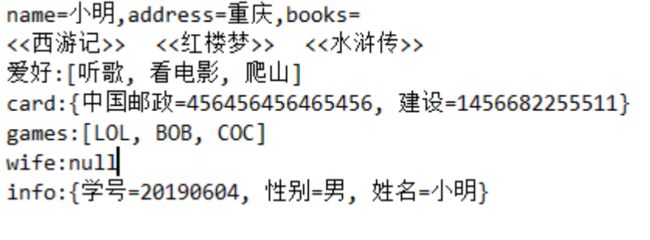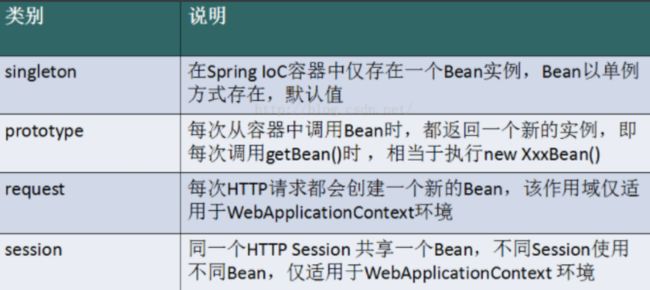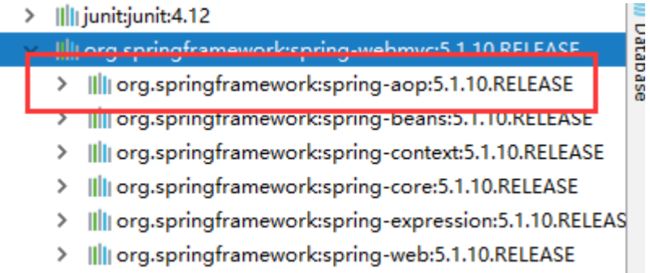Spring的配置、依赖注入、Bean的自动装配及注解开发
Spring配置
1. 别名
alias 设置别名 , 为bean设置别名 , 可以设置多个别名
| 1 2 |
|
2. Bean的配置
| 1 2 3 4 5 6 7 8 9 10 11 12 13 |
|
3. import
团队的合作通过import来实现 .
| 1 |
|
依赖注入(DI)
- 依赖注入(Dependency Injection,DI)。
- 依赖 : 指Bean对象的创建依赖于容器 . Bean对象的依赖资源 .
- 注入 : 指Bean对象所依赖的资源 , 由容器来设置和装配 .
1 构造器注入
在上一篇博客已经详细讲过了
2 set注入 (重点)
要求被注入的属性 , 必须有set方法 , set方法的方法名由set + 属性首字母大写 , 如果属性是boolean类型 , 没有set方法 , 是 is .
测试pojo类 :
Address.java
| 1 2 3 4 5 6 7 8 9 |
|
Student.java
| 1 2 3 4 5 6 7 8 9 10 11 12 13 14 15 16 17 18 19 20 21 22 23 24 25 26 27 28 29 30 31 32 33 34 35 36 37 38 39 40 41 42 43 44 45 46 47 48 49 50 51 52 53 |
|
2、1 常量注入
| 1 2 3 |
|
测试:
| 1 2 3 4 5 6 |
|
2、2 Bean注入
注意点:这里的值是一个引用,ref
| 1 2 3 4 5 6 7 |
|
2、3 数组注入
| 1 2 3 4 5 6 7 8 9 10 11 |
|
2、4 List注入
| 1 2 3 4 5 6 7 |
|
2、5 Map注入
| 1 2 3 4 5 6 |
|
2、6 set注入
| 1 2 3 4 5 6 7 |
|
2、7 Null注入
| 1 |
|
2、8 Properties注入
| 1 2 3 4 5 6 7 |
|
测试结果:
3 拓展注入实现
User.java : 【注意:这里没有有参构造器!】
| 1 2 3 4 5 6 7 8 9 10 11 12 13 14 15 16 17 |
|
1、P命名空间注入 : 需要在头文件中假如约束文件
| 1 2 3 |
|
2、c 命名空间注入 : 需要在头文件中假如约束文件
| 1 2 3 |
|
发现问题:爆红了,刚才我们没有写有参构造!
解决:把有参构造器加上,这里也能知道,c 就是所谓的构造器注入!
测试代码:
| 1 2 3 4 5 6 |
|
4 Bean的作用域
在Spring中,那些组成应用程序的主体及由Spring IoC容器所管理的对象,被称之为bean。简单地讲, bean就是由IoC容器初始化、装配及管理的对象 .
几种作用域中,request、session作用域仅在基于web的应用中使用(不必关心你所采用的是什么web 应用框架),只能用在基于web的Spring ApplicationContext环境。
4.1 Singleton
当一个bean的作用域为Singleton,那么Spring IoC容器中只会存在一个共享的bean实例,并且所有对 bean的请求,只要id与该bean定义相匹配,则只会返回bean的同一实例。Singleton是单例类型,就是 在创建起容器时就同时自动创建了一个bean的对象,不管你是否使用,他都存在了,每次获取到的对象 都是同一个对象。注意,Singleton作用域是Spring中的缺省作用域。要在XML中将bean定义成 singleton,可以这样配置:
| 1 |
|
测试:
| 1 2 3 4 5 6 7 |
|
4.2 Prototype
当一个bean的作用域为Prototype,表示一个bean定义对应多个对象实例。Prototype作用域的bean会 导致在每次对该bean请求(将其注入到另一个bean中,或者以程序的方式调用容器的getBean()方法) 时都会创建一个新的bean实例。Prototype是原型类型,它在我们创建容器的时候并没有实例化,而是 当我们获取bean的时候才会去创建一个对象,而且我们每次获取到的对象都不是同一个对象。根据经 验,对有状态的bean应该使用prototype作用域,而对无状态的bean则应该使用singleton作用域。在 XML中将bean定义成prototype,可以这样配置:
| 1 2 3 |
|
4.3 Request
当一个bean的作用域为Request,表示在一次HTTP请求中,一个bean定义对应一个实例;即每个HTTP 请求都会有各自的bean实例,它们依据某个bean定义创建而成。该作用域仅在基于web的Spring ApplicationContext情形下有效。考虑下面bean定义:
| 1 |
|
针对每次HTTP请求,Spring容器会根据loginAction bean的定义创建一个全新的LoginAction bean实 例,且该loginAction bean实例仅在当前HTTP request内有效,因此可以根据需要放心的更改所建实例 的内部状态,而其他请求中根据loginAction bean定义创建的实例,将不会看到这些特定于某个请求的 状态变化。当处理请求结束,request作用域的bean实例将被销毁。
4.4 Session
当一个bean的作用域为Session,表示在一个HTTP Session中,一个bean定义对应一个实例。该作用域 仅在基于web的Spring ApplicationContext情形下有效。考虑下面bean定义:
| 1 |
|
针对某个HTTP Session,Spring容器会根据userPreferences bean定义创建一个全新的 userPreferences bean实例,且该userPreferences bean仅在当前HTTP Session内有效。与request作 用域一样,可以根据需要放心的更改所创建实例的内部状态,而别的HTTP Session中根据 userPreferences创建的实例,将不会看到这些特定于某个HTTP Session的状态变化。当HTTP Session 最终被废弃的时候,在该HTTP Session作用域内的bean也会被废弃掉。
Bean的自动装配
- 自动装配是使用spring满足bean依赖的一种方法
- spring会在应用上下文中为某个bean寻找其依赖的bean。
Spring中bean有三种装配机制,分别是:
- 在xml中显式配置;
- 在java中显式配置;
- 隐式的bean发现机制和自动装配。
这里我们主要讲第三种:自动化的装配bean。
Spring的自动装配需要从两个角度来实现,或者说是两个操作:
- 组件扫描(component scanning):spring会自动发现应用上下文中所创建的bean;
- 自动装配(autowiring):spring自动满足bean之间的依赖,也就是我们说的IoC/DI;
组件扫描和自动装配组合发挥巨大威力,使的显示的配置降低到最少。
推荐不使用自动装配xml配置 , 而使用注解 .
1、测试环境搭建
1. 新建一个项目
2. 新建两个实体类,Cat Dog 都有一个叫的方法
| 1 2 3 4 5 |
|
| 1 2 3 4 5 |
|
3. 新建一个用户类 User
| 1 2 3 4 5 |
|
4. 编写Spring配置文件
![]()
![]()
5. 测试
| 1 2 3 4 5 6 7 8 9 |
|
结果正常输出,环境OK
2、byName
autowire byName (按名称自动装配)
由于在手动配置xml过程中,常常发生字母缺漏和大小写等错误,而无法对其进行检查,使得开发效率 降低。
采用自动装配将避免这些错误,并且使配置简单化。
测试:
1. 修改bean配置,增加一个属性 autowire="byName"
| 1 2 3 |
|
2. 再次测试,结果依旧成功输出!
3. 我们将 cat 的bean id修改为 catXXX
4. 再次测试, 执行时报空指针java.lang.NullPointerException。因为按byName规则找不对应set方 法,真正的setCat就没执行,对象就没有初始化,所以调用时就会报空指针错误。
小结:
当一个bean节点带有 autowire byName的属性时。
- 将查找其类中所有的set方法名,例如setCat,获得将set去掉并且首字母小写的字符串,即cat。
- 去spring容器中寻找是否有此字符串名称id的对象。
- 如果有,就取出注入;如果没有,就报空指针异常。
3、byType
autowire byType (按类型自动装配)
使用autowire byType首先需要保证:同一类型的对象,在spring容器中唯一。如果不唯一,会报不唯一 的异常。
| 1 |
|
测试:
1. 将user的bean配置修改一下 : autowire="byType"
2. 测试,正常输出
3. 在注册一个cat 的bean对象!
| 1 2 3 4 5 6 |
|
4. 测试,报错:NoUniqueBeanDefinitionException
5. 删掉cat2,将cat的bean名称改掉!测试!因为是按类型装配,所以并不会报异常,也不影响最后 的结果。甚至将id属性去掉,也不影响结果。
这就是按照类型自动装配!
4 使用注解
jdk1.5开始支持注解,spring2.5开始全面支持注解。
准备工作: 利用注解的方式注入属性。
1. 在spring配置文件中引入context文件头
| 1 2 3 4 |
|
2. 开启属性注解支持!
| 1 |
|
4.1、@Autowired
- @Autowired是按类型自动转配的,不支持id匹配。
- 需要导入 spring-aop的包!
测试:
1. 将User类中的set方法去掉,使用@Autowired注解
| 1 2 3 4 5 6 7 8 9 10 11 12 13 14 15 16 |
|
2. 此时配置文件内容
| 1 2 3 4 |
|
3. 测试,成功输出结果!
【科普】
@Autowired(required=false) 说明: false,对象可以为null;true,对象必须存对象,不能为null。
| 1 2 3 |
|
4.2、@Qualifier
- @Autowired是根据类型自动装配的,加上@Qualifier则可以根据byName的方式自动装配
- @Qualifier不能单独使用。
测试实验步骤:
1. 配置文件修改内容,保证类型存在对象。且名字不为类的默认名字!
| 1 2 3 4 |
|
2. 没有加Qualifier测试,直接报错
3. 在属性上添加Qualifier注解
| 1 2 3 4 5 6 |
|
4. 测试,成功输出!
4.3、@Resource
- @Resource如有指定的name属性,先按该属性进行byName方式查找装配;
- 其次再进行默认的byName方式进行装配;
- 如果以上都不成功,则按byType的方式自动装配。
- 都不成功,则报异常。
实体类:
| 1 2 3 4 5 6 7 8 |
|
beans.xml
| 1 2 3 4 |
|
测试:结果OK
配置文件2:beans.xml , 删掉cat2
| 1 2 |
|
实体类上只保留注解
| 1 2 3 4 |
|
结果:OK
结论:先进行byName查找,失败;再进行byType查找,成功。
5、小结
@Autowired与@Resource异同:
- @Autowired与@Resource都可以用来装配bean。都可以写在字段上,或写在setter方法上。
- @Autowired默认按类型装配(属于spring规范),默认情况下必须要求依赖对象必须存在,如果 要允许null 值,可以设置它的required属性为false,如:@Autowired(required=false) ,如果我 们想使用名称装配可以结合@Qualifier注解进行使用
- @Resource(属于J2EE复返),默认按照名称进行装配,名称可以通过name属性进行指定。如果 没有指定name属性,当注解写在字段上时,默认取字段名进行按照名称查找,如果注解写在 setter方法上默认取属性名进行装配。 当找不到与名称匹配的bean时才按照类型进行装配。但是 需要注意的是,如果name属性一旦指定,就只会按照名称进行装配。
它们的作用相同都是用注解方式注入对象,但执行顺序不同。@Autowired先byType,@Resource先 byName。
使用注解开发
1、说明
在spring4之后,想要使用注解形式,必须得要引入aop的包
在配置文件当中,还得要引入一个context约束
| 1 2 3 4 5 6 7 8 9 |
|
2、Bean的实现
我们之前都是使用 bean 的标签进行bean注入,但是实际开发中,我们一般都会使用注解!
1. 配置扫描哪些包下的注解
| 1 2 |
|
2. 在指定包下编写类,增加注解
| 1 2 3 4 5 |
|
3. 测试
| 1 2 3 4 5 6 |
|
3、属性注入
使用注解注入属性
1. 可以不用提供set方法,直接在直接名上添加@value("值")
| 1 2 3 4 5 6 7 |
|
2. 如果提供了set方法,在set方法上添加@value("值");
| 1 2 3 4 5 6 7 8 |
|
4、衍生注解
我们这些注解,就是替代了在配置文件当中配置步骤而已!更加的方便快捷!
@Component三个衍生注解
为了更好的进行分层,Spring可以使用其它三个注解,功能一样,目前使用哪一个功能都一样。
- @Controller:web层
- @Service:service层
- @Repository:dao层
写上这些注解,就相当于将这个类交给Spring管理装配了!
5、自动装配注解
在Bean的自动装配已经讲过了,可以回顾!
6、作用域
@scope
- singleton:默认的,Spring会采用单例模式创建这个对象。关闭工厂 ,所有的对象都会销毁。
- prototype:多例模式。关闭工厂 ,所有的对象不会销毁。内部的垃圾回收机制会回收
| 1 2 3 4 5 6 |
|
7、小结
XML与注解比较
- XML可以适用任何场景 ,结构清晰,维护方便
- 注解不是自己提供的类使用不了,开发简单方便
xml与注解整合开发 :推荐最佳实践
- xml管理Bean
- 注解完成属性注入
- 使用过程中, 可以不用扫描,扫描是为了类上的注解
| 1 |
|
作用:
- 进行注解驱动注册,从而使注解生效
- 用于激活那些已经在spring容器里注册过的bean上面的注解,也就是显示的向Spring注册
- 如果不扫描包,就需要手动配置bean
- 如果不加注解驱动,则注入的值为null!
8、基于Java类进行配置
JavaConfig 原来是 Spring 的一个子项目,它通过 Java 类的方式提供 Bean 的定义信息,在 Spring4 的 版本, JavaConfig 已正式成为 Spring4 的核心功能 。
测试:
1. 编写一个实体类,Dog
| 1 2 3 4 |
|
2. 新建一个config配置包,编写一个MyConfig配置类
| 1 2 3 4 5 6 7 |
|
3. 测试
| 1 2 3 4 5 6 |
|
4. 成功输出结果!
导入其他配置如何做呢?
1. 我们再编写一个配置类!
| 1 2 3 |
|
2. 在之前的配置类中我们来选择导入这个配置类
| 1 2 3 4 5 6 7 8 |
|
关于这种Java类的配置方式,我们在之后的SpringBoot 和 SpringCloud中还会大量看到,我们需要知道 这些注解的作用即可!


